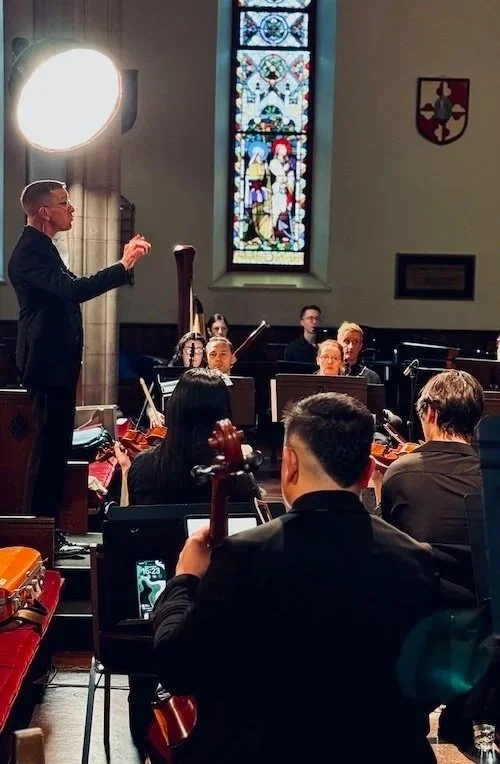Thank you to the Seth Arenstein for his thoughtful review of “Requiem” for the Washington Classical Review.
Emmanuel Choir marks All Saints’ Day with Requiem premiere and contrasting Mass
By Seth Arenstein, Monday November 3, 2025
“Graham Gordon Ramsay composed his Requiem as a response to human loss, his own aging, and as he said in a program note, “the tumultuous world of 2025.” Sarah Kirkland Snider’s Mass for the Endangered focuses on the rapid extinction of non-human species and humanity’s role in it.
A virtuoso performance of both works given by the Emmanuel Choir Sunday afternoon emphasized music’s ability to transmit the beauty and energy of life while providing a vehicle for grief. Fittingly, the concert took place on All Saints’ Day, at Emmanuel Episcopal Church in Baltimore.
The choir and Emmanuel’s music director, Christian Lane, commissioned the Requiem, which received its world premiere at this concert. Lane built an outstanding chorus during the Covid era, which the composer had heard several times. Lane picked the players for the orchestra specifically for this premiere.
The Kyrie began with a sombre, repeating quarter note, played softly from Yoshi Horiguchi’s double-bass, which was repeated several times throughout the piece, providing a familiar feeling of composure and eventually resolution.
Another indication of Lane picking specific players suited for the work was heard later, when cellist Steven Chen joined with the first of his solos, previewing longer opportunities in the Requiem to display a rich sound and expressive phrasing. Later, a muted French horn joined, followed by the choir, still softly, until the mood changed with fortissimo singing, the organ supplementing the sound, though not overpowering it.
This pattern of soft and loud contrasts was repeated in the Offertorium, though this time several traditional-sounding blasts from the organ and even louder notes from the singers interrupted the somber character that dominated the composition.
This Requiem benefited from careful ensemble balance, as Ramsay’s writing for the orchestra gave it a co-leading role with the singers. As such, Ramsay provided solos for every player. Without a sensitive conductor, these moments would be lost and the orchestra could overwhelm the vocalists or vice versa. Lane paid meticulous attention to balance. Despite moments of strength, the overall effect was one of control. Even when the Requiem ended, as orchestra and vocalists sounded an ascending chromatic scale, which began loudly, it then faded to a piccolo rising above a pedal of organ and double bass.
In addition to being balanced, Ramsay’s instrumental writing was a treat, producing instances of unusual voicing. For example, in the Offertorium, where Dillon Parker’s soft, muted trumpet combined exquisitely with the English horn and later clarinet, oboe, and bassoon.
Another creative touch had the chorus singing in Latin, and the soloists — the standard soprano, alto, tenor, and bass — in English, except in the brief Pie Jesu, where soprano Nicole Stover joined golden-voiced alto Kaylee Parker for a duet in Latin. The mix of English and Latin was seamless, and the English-language solos helped accessibility, since the otherwise excellent program book lacked a Latin text.
Snider’s Mass for the Endangered, which rightly has continued to gain notoriety since its 2018 premiere, also mixes English and Latin, though it’s largely the English texts and poems of librettist Nathaniel Bellows.
There are similarities between the Snider and Ramsay works—both begin with soft double-bass figures, and both feature terrific writing for the instrumental accompanists. Yet the text of Snider’s Mass is slightly more demonstrative, emotional, and vivid. It’s also a bit less hopeful and contains more guilt than Ramsay’s Requiem. For instance, instead of a joyful Alleluia, the text here includes “Contour, carve, corrode … Poison, parch, pollute — plow the coast, the dune … Fracture, foist, defoul — shatter cliff and shoal, sand each stone to whole.”
However, like the Requiem, the Mass is an exercise in balance, mostly in the vocal parts: its signature theme is unison chordal singing, laced with subtle soprano solos, some lingering momentarily as the ensemble finished a phrase. The solos were handled beautifully by Kayleigh Sprouse and Lauren Kim. Both used a stoic tone that worked perfectly with the intense, though cold, ensemble vibe heard throughout the Mass.
Also notable were the tasteful sounds of flautist Giorgio Consolati and harpist Jacqueline Pollauf, floating in and around many of the sections. String players CJ Claire Li, Archangel Luniw, and Max Krzak appropriately slammed their strings, registering displeasure, during the Credo. Li’s sustained high notes at various moments, often accompanied by the organ, added poignancy throughout.
In all, these were memorable performances of top-notch compositions that deserve much more exposure.”


